From endpoint to XDR: Operationalize CrowdStrike data in Elastic Security
Integrate CrowdStrike endpoint data within Elastic Security to enhance your threat detection, investigation, and response capabilities.

Many security teams often struggle with threat detection and response because of disjointed visibility and isolated endpoint data. This challenge led to the development of extended detection and response (XDR), which integrates endpoint insights with contextualized data from various sources like networks, cloud environments, and identity systems. Endpoint security tools are vital for threat visibility, but they only offer a limited perspective. Endpoint data alone lacks the broader context needed to fully understand and mitigate threats across an organization's entire attack surface.
True XDR requires a comprehensive approach that goes beyond isolated endpoint telemetry. Elastic Security offers AI-driven security analytics, delivering unified threat detection, investigation, and response without requiring another XDR tool. Elastic provides a single platform that eliminates silos, reduces tool sprawl, and cuts costs, providing a more efficient and holistic defense against modern cyber threats.
Elastic Security integrates with CrowdStrike to operationalize its data alongside signals from network, identity, and cloud sources, offering a complete threat picture. By ingesting CrowdStrike telemetry into Elastic Security, organizations can gain deeper visibility and take decisive security actions with advanced analytics, AI-driven assistance, and robust response capabilities.
Elastic Security ingests and normalizes data from hundreds of sources, providing a unified view of threats. Backed by Elastic Security Labs’ threat research and machine learning, detection rules surface suspicious activity in real time. Elastic’s open, scalable ecosystem ensures defenders can correlate CrowdStrike alerts with other data sources, accelerating investigations and response. With a unified approach to security operations, teams gain the context they need to detect and mitigate threats before they escalate.
Integrating CrowdStrike endpoint data with Elastic Security
Organizations can combine CrowdStrike's deep endpoint telemetry with Elastic Security to create a stronger XDR strategy. By integrating CrowdStrike data from sources like Falcon SIEM Connector, CrowdStrike Event Stream, and Falcon Data Replicator, security teams can ingest endpoint alerts, event telemetry, process execution data, and forensic artifacts directly into Elastic Security. Beyond endpoint telemetry, Elastic’s CrowdStrike integration supports additional capabilities, including vulnerability data and threat intelligence. This enables security teams to enrich investigations with contextual data such as asset vulnerability details, exploitability insights, and intelligence on known adversaries.
By normalizing all this data to Elastic Common Schema (ECS), analysts gain a cohesive view of threats and can apply uniform detection, correlation, and response workflows across different domains. This integration transforms CrowdStrike from an isolated EDR tool into part of a full-scale, cross-domain detection and response strategy.
Moreover, Elastic Security's detection engine can run prebuilt correlation rules and machine learning jobs on CrowdStrike events just as it would on native Elastic Security endpoint data, allowing defenders to apply advanced analytics uniformly to all security events in Elastic. Teams can immediately leverage Elastic Security’s curated ruleset on incoming CrowdStrike alerts for an added layer of defense, as Elastic’s own library of endpoint detection rules is compatible with CrowdStrike Falcon data.
Threat detection with Elastic's AI-driven security analytics
Elastic Security provides a wide range of prebuilt detection rules, behavior analytics, and machine learning models, allowing Security teams to quickly leverage their CrowdStrike data without needing to build their own analytics from scratch.
Elastic's machine learning jobs can detect anomalies in CrowdStrike telemetry and identify suspicious behaviors that traditional rule-based detections may miss. Analysts can create custom rules specific to their organization's environment to enrich CrowdStrike alerts with additional security context. Using Elastic's open, extensible data model allows security teams to apply unified detections across endpoints, networks, cloud workloads, and identity systems enabling true cross-domain threat detection.
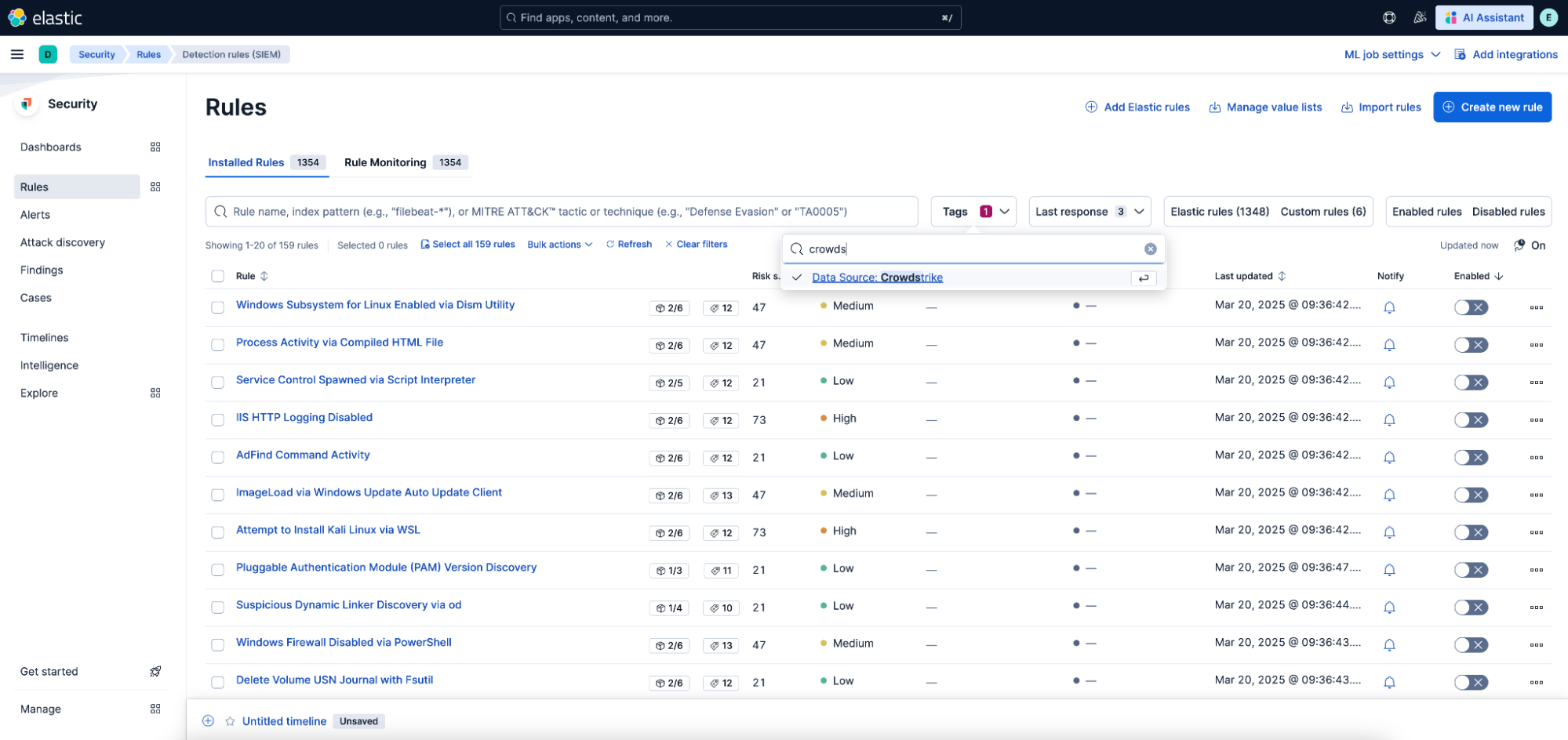
Investigate CrowdStrike data with Elastic Security
AI-driven investigations with Elastic AI Assistant
Elastic AI Assistant enhances security investigations by integrating generative AI directly into the analyst workflow. When CrowdStrike data is ingested into Elastic Security, the AI Assistant accelerates understanding and response by offering contextual insights, explanations, and recommended actions.
Alert explainability and remediation suggestions
Elastic AI Assistant for Security can analyze and summarize CrowdStrike alerts to explain why an alert was triggered and what it means. This assists security analysts with alert triage. For example, when a CrowdStrike alert is triggered, analysts can ask the AI Assistant, “What is this alert telling me?” The assistant provides a breakdown, such as the figure shown below. This immediate context helps analysts quickly understand threats without needing to pivot to external sources.
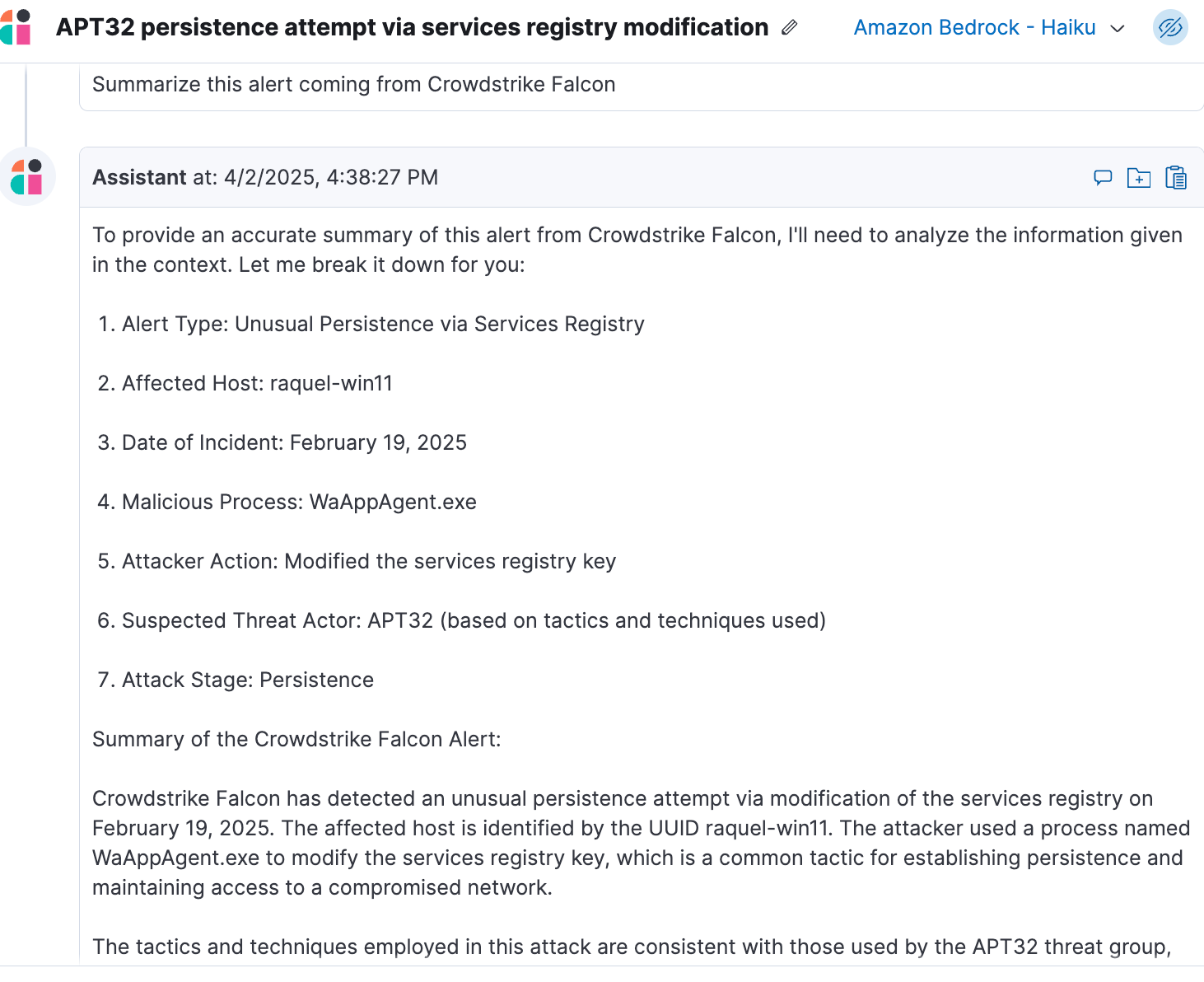
Beyond explanations, Elastic AI Assistant recommends remediation steps based on the alert details and historical responses to similar threats. If an alert indicates potential malware activity, it may suggest isolating the affected endpoint, terminating the malicious process, and searching for related indicators of compromise (IOCs) across the environment. This AI-driven guidance ensures that security teams can take effective actions without delays.
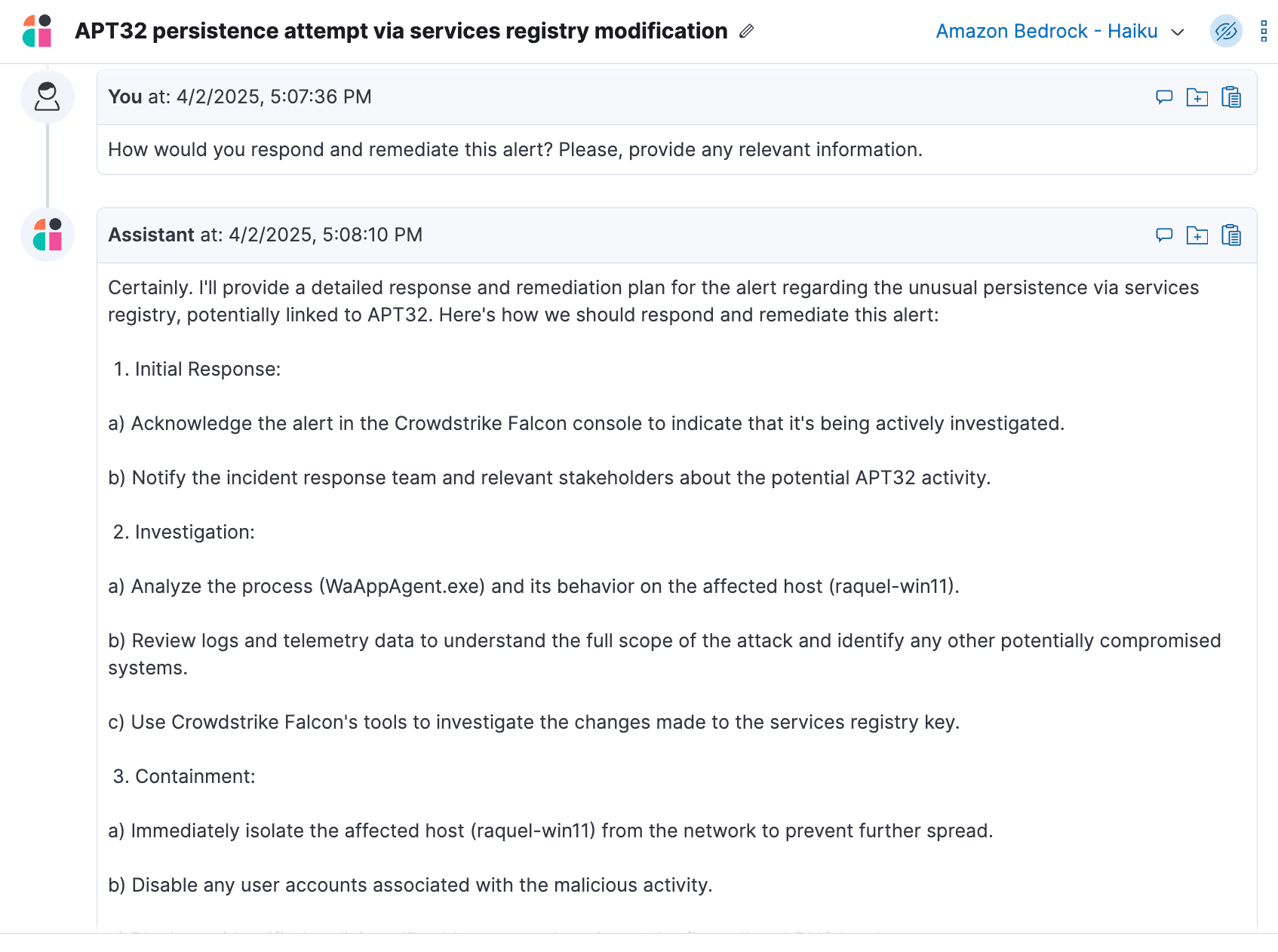
Custom knowledge source integration
Since the release of Elastic Security 8.16, AI Assistant for Security now integrates with custom knowledge sources, providing answers tailored to an organization's specific security practices and threat landscape. These sources include threat intelligence feeds, internal playbooks, and wikis. Analysts can leverage their environment's unique procedures and past incidents when investigating alerts, asking questions like, "Was this malware present in our environment before?" AI Assistant would then search indexed internal incident reports or threat intel feeds in Elastic for relevant information.
Attack Discovery: Automated threat correlation and context
Elastic Security’s Attack Discovery leverages AI-driven analytics to correlate CrowdStrike alerts with signals from other security domains, such as cloud, network, and identity data. Instead of analyzing alerts in isolation, analysts can see the full attack chain mapped to MITRE ATT&CK tactics and techniques. This reduces manual effort in alert triage and enables faster, more confident responses.
For instance, an analyst investigating a potential credential theft alert from CrowdStrike may find that Attack Discovery is able to link it to suspicious lateral movement attempts observed in network logs. This broader attack context allows defenders to respond proactively and mitigate threats before they escalate.
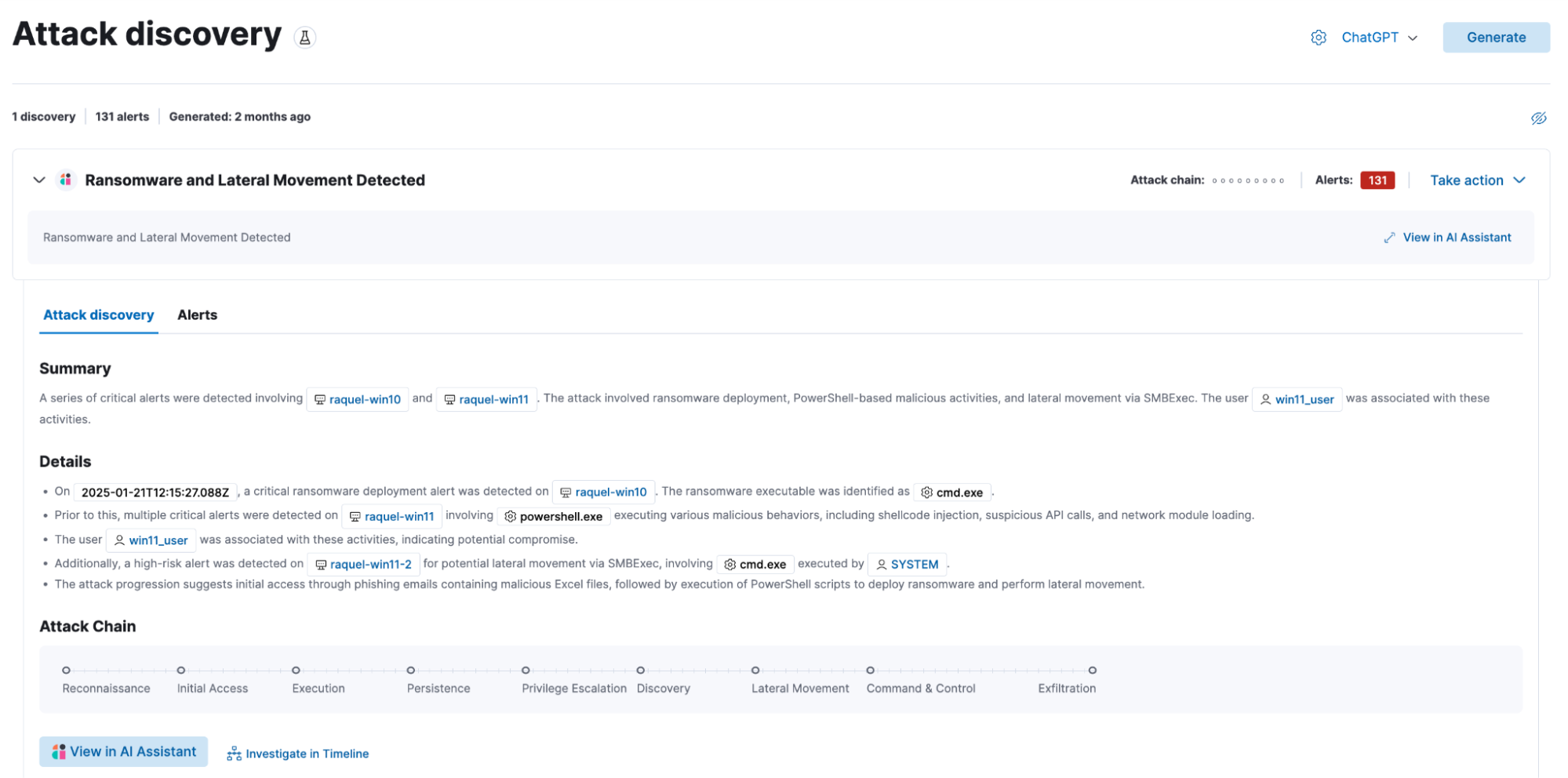
Interactive dashboards and visualizations
CrowdStrike data is immediately actionable within Elastic’s visualization and investigation tools. Prebuilt Kibana dashboards provide visibility into endpoint activity, attack trends, and threat patterns mapped to the MITRE ATT&CK framework.
Analysts can drill into specific alerts leveraging Timelines to reconstruct incidents across multiple data sources. These tools integrate CrowdStrike data into a unified investigation workflow, enhancing detection, correlation, forensic analysis, and threat hunting capabilities.
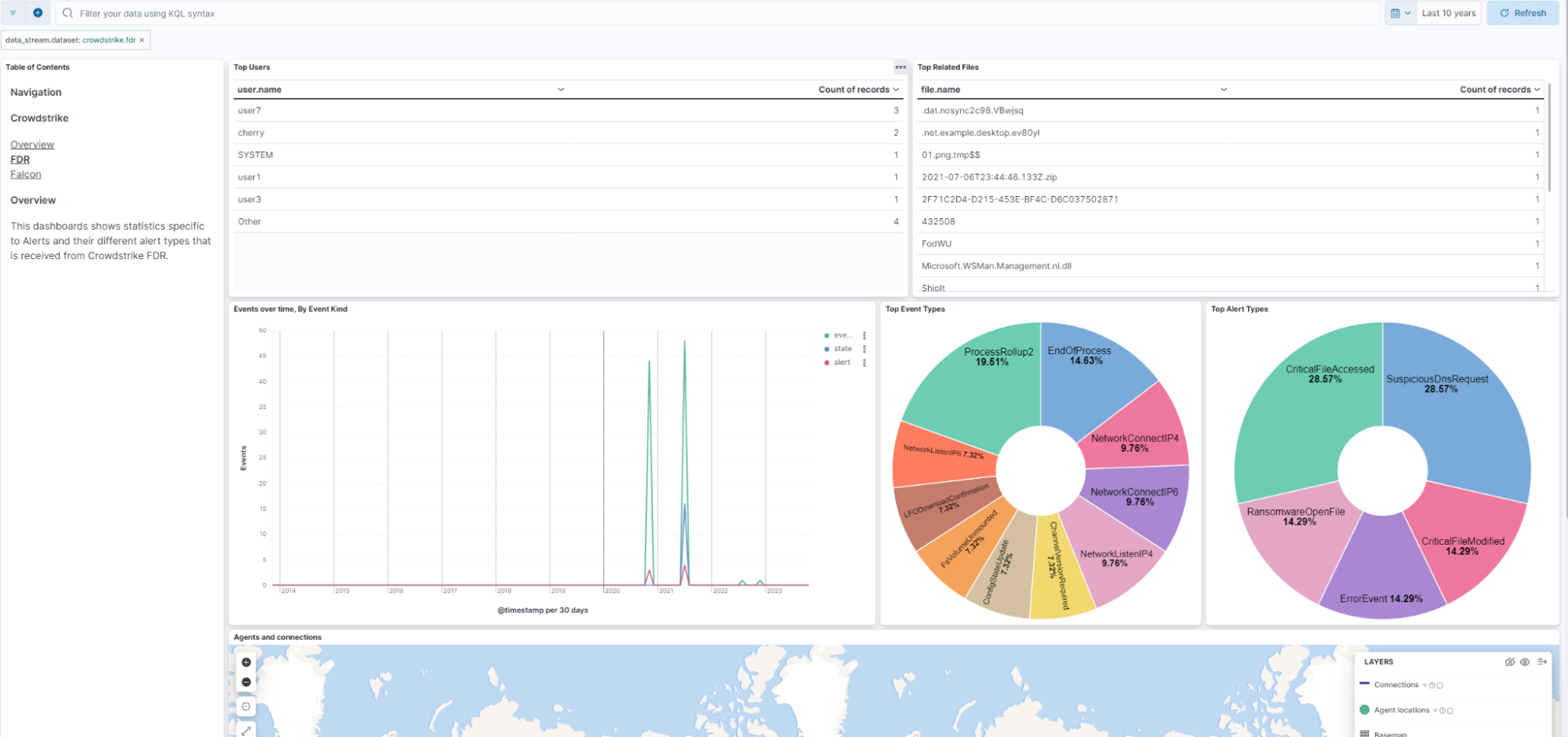
Taking action on CrowdStrike alerts
Elastic Security enables bidirectional response actions for CrowdStrike endpoints directly within the Elastic interface. Analysts can initiate key response actions without switching between tools, reducing attacker dwell time and accelerating containment.
Elastic Security supports isolating and releasing endpoints directly from the platform, preventing further compromise during an active attack. Additionally, CrowdStrike’s runscript capability allows analysts to execute remote commands or run scripts on target hosts, providing deeper forensic and remediation capabilities. These actions empower security teams to quickly contain threats and neutralize malicious activity without disrupting operations.

Long-term visibility and advanced analytics
The more high-fidelity data you bring into Elastic Security, the stronger your security posture becomes. CrowdStrike provides deep endpoint visibility, but Elastic enhances that visibility with cost-effective long-term data retention and storage as well as advanced analytics. Security teams can store CrowdStrike telemetry in Elastic’s data lake, allowing for historical investigations and compliance reporting without the high costs of retaining data in expensive storage solutions.
Elastic’s Search AI Lake extends analytics capabilities by applying advanced search and machine learning techniques to CrowdStrike data. This approach enables proactive threat hunting, anomaly detection, and real-time security insights that go beyond simple log aggregation. Cross-cluster search allows organizations to correlate data across multiple Elastic deployments, ensuring defenders have the full context necessary for accurate decision-making. Also, with searchable snapshots, analysts can access archived data instantly without manual rehydration, maintaining full security visibility while optimizing storage costs.
By centralizing CrowdStrike data in Elastic Security, organizations can move beyond short-term incident response to a strategic, long-term approach to security data management. This ensures continuous visibility, compliance readiness, and a proactive stance against evolving threats.
Reducing blind spots with Elastic Defend
In hybrid environments, many organizations have deployed CrowdStrike only on some endpoints. Elastic Security provides a unified approach by allowing teams to deploy Elastic Defend on endpoints not covered by CrowdStrike. This ensures consistent security monitoring, regardless of endpoint coverage, and enables defenders to analyze all endpoint telemetry within the same workflow.
Elastic Defend and CrowdStrike together provide comprehensive endpoint protection, while allowing security teams to investigate and respond using a single platform. Analysts can use the same detection rules, correlation logic, and automated workflows to simplify security operations in diverse environments, regardless of whether they are ingesting CrowdStrike alerts or collecting data from Elastic Defend agents.
Security that’s always one step ahead
Elastic Security and CrowdStrike endpoint data integration creates a powerful, unified security operation. This allows SOC teams to gain complete attack visibility, investigate incidents with AI-assisted correlation, and respond rapidly from a single interface. Since attackers move across endpoints, networks, and cloud services, endpoint data alone is insufficient. A unified platform approach breaks down data silos and adds analytical depth to endpoint telemetry.
For SOC leaders, this integration maximizes endpoint security investments by providing faster incident response, richer investigations, and long-term security insights. By leveraging Elastic’s open, scalable ecosystem and CrowdStrike’s endpoint strengths, security teams can accelerate threat detection and response workflows, staying ahead of adversaries in an ever-changing threat landscape.
Get started with Elastic Security
Start your free trial of Elastic Security today and experience the benefits of integrating your CrowdStrike endpoint data with Elastic Security. Enhance defenses and improve threat response by accelerating threat detection, investigation, and remediation.
The release and timing of any features or functionality described in this post remain at Elastic's sole discretion. Any features or functionality not currently available may not be delivered on time or at all.
In this blog post, we may have used or referred to third party generative AI tools, which are owned and operated by their respective owners. Elastic does not have any control over the third party tools and we have no responsibility or liability for their content, operation or use, nor for any loss or damage that may arise from your use of such tools. Please exercise caution when using AI tools with personal, sensitive or confidential information. Any data you submit may be used for AI training or other purposes. There is no guarantee that information you provide will be kept secure or confidential. You should familiarize yourself with the privacy practices and terms of use of any generative AI tools prior to use.
Elastic, Elasticsearch, ESRE, Elasticsearch Relevance Engine and associated marks are trademarks, logos or registered trademarks of Elasticsearch N.V. in the United States and other countries. All other company and product names are trademarks, logos or registered trademarks of their respective owners.

